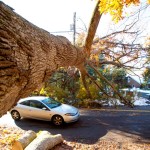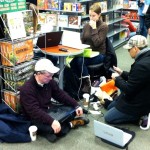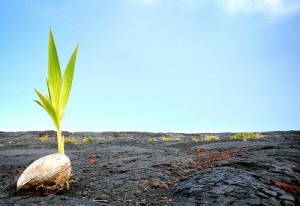 What happens when we are confronted with trauma in our lives, in our homes, in our communities, and in our businesses? Here are my recent experiences with that question, and what ends up being a surprising answer.
What happens when we are confronted with trauma in our lives, in our homes, in our communities, and in our businesses? Here are my recent experiences with that question, and what ends up being a surprising answer.
A few weeks before most of Connecticut lost power last October I was sitting in my car waiting to turn into our office when I heard screeching tires behind me and looked up in time to see a car who hadn’t seen me, smash into me, pushing me into the car I was waiting behind. I was stunned, but not physically injured (seat belt), and only in the days that followed did I come to learn how a trauma like this would subtly effect me in the months to come as I slowly recovered (I was ultimately diagnosed as having a concussion).
 In that October storm we all lived thru a seismic change in our daily lives and most of us developed a profound new understanding and appreciation for the role that readily available energy plays in our daily lives. I joined the digital refugees, hunting down libraries or coffee shops where we could charge our phones and computers and get a working WiFi connection to check our email – then home to sleep in the cold dark house. This uninvited event drew people together even as it unsettled our lives. It revealed surprising lessons about what truly matters.
In that October storm we all lived thru a seismic change in our daily lives and most of us developed a profound new understanding and appreciation for the role that readily available energy plays in our daily lives. I joined the digital refugees, hunting down libraries or coffee shops where we could charge our phones and computers and get a working WiFi connection to check our email – then home to sleep in the cold dark house. This uninvited event drew people together even as it unsettled our lives. It revealed surprising lessons about what truly matters.
 Two days before my father Arthur’s 88th Valentines Day birthday he died the comfortable death we all hope for: at the end of a long, full, and accomplished life, at home, safe and comfortable, without tubes or monitors, and with time to spend with those he loved. In the service we held to remember his life I recalled that the hole left is also a whole profoundly felt. As anyone who has experienced a loss knows, it settles into you on its own terms and what rises from it can be as rich as it is sad.
Two days before my father Arthur’s 88th Valentines Day birthday he died the comfortable death we all hope for: at the end of a long, full, and accomplished life, at home, safe and comfortable, without tubes or monitors, and with time to spend with those he loved. In the service we held to remember his life I recalled that the hole left is also a whole profoundly felt. As anyone who has experienced a loss knows, it settles into you on its own terms and what rises from it can be as rich as it is sad.
A week ago our dog Zeke was hit full on by a car in front of our house, nearly died, and is rather miraculously regaining his body functions, including the repair of a nasty leg fracture and neurologic damage that will only slowly return the use of his limbs. Worrying about him, his chance for recovery, and now patiently nursing him to health is providing a visceral relationship with the trauma he endured and the body’s ability to heal.
Nearly three years ago, along with the rest of the housing industry, Wolfworks had to confront a market that could not support our staff and overhead – there was no work. We had some design work, but it progressed cautiously and it was nearly a year before we were building again. Needless to say, as it was for all in our industry, this was challenging.
Trauma, by definition, is the result of some unexpected force that upsets our familiar relationships with the world, the body, the home, the community, the business we live with and in. In time we recover, but to what? Recent studies reveal this surprising answer: Growth: Personal. Professional. Family. Community.
And this idea comes with what I think is a useful name: Post Traumatic Growth! We adapt. And we grow.
 Post traumatic growth demonstrates the resilience of the body, the spirit, the people, and the communities that experience seismic changes in some dimension of their once familiar world. Across this spectrum, as often as not, the trauma makes way for something new to emerge that can be fuller, richer, deeper and more engaged than what preceded the event. Communities recovering from natural disasters, soldiers returning from war with lost limbs and lost comrades, and most immediately me and my dog recovering from car accidents, the loss of my father, and the changes in our industry; each offers the opportunity to respond to the event with a renewed sense of possibility and potential. I’m not saying its easy, far from it. Just that, as they say, “from the ashes…”
Post traumatic growth demonstrates the resilience of the body, the spirit, the people, and the communities that experience seismic changes in some dimension of their once familiar world. Across this spectrum, as often as not, the trauma makes way for something new to emerge that can be fuller, richer, deeper and more engaged than what preceded the event. Communities recovering from natural disasters, soldiers returning from war with lost limbs and lost comrades, and most immediately me and my dog recovering from car accidents, the loss of my father, and the changes in our industry; each offers the opportunity to respond to the event with a renewed sense of possibility and potential. I’m not saying its easy, far from it. Just that, as they say, “from the ashes…”
Wolfworks’ post traumatic growth took place as we quickly came to understand that how we design and build, and the guidance we provide to the clients we serve, needed to acknowledge not just the economic challenges we faced, but the environmental and cultural challenges we will experience as we face the end of cheap energy, the limits to non-renewable resources, and disturbances to ours climate.
The good news is that as we embraced this reality, as we grew and learned and changed, we realized that what we could design and build was remarkably better in nearly every way than what we knew before. The ways we know to build now are safer, simpler, healthier, more comfortable, durable, and are miserly in their use of energy. Best of all, we now know how to create homes that are contributing to the solution, rather than adding to the problem. So we have adapted and we have grown, and as a result of our “post traumatic growth” we are better equipped to guide you.
